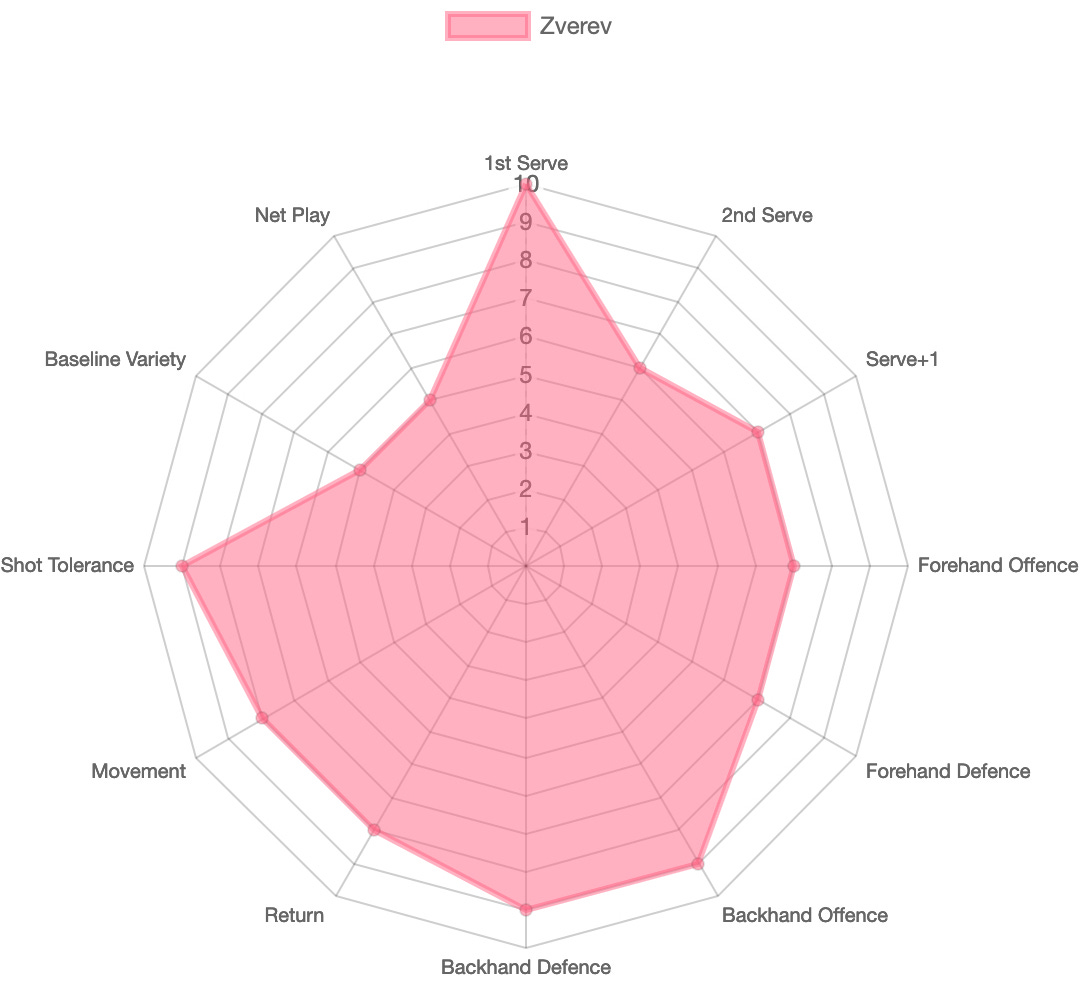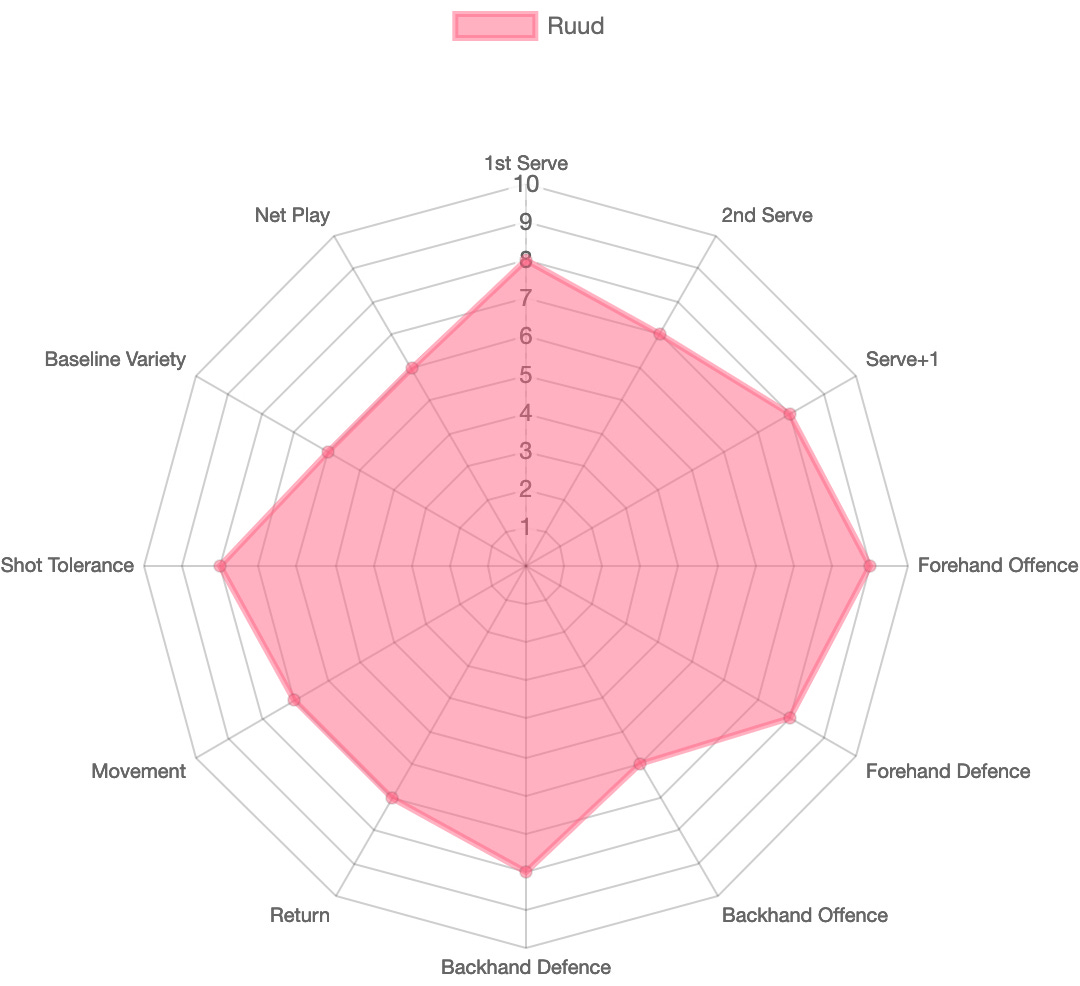The Top 10 As Video Game Characters
Skill attributes, Strength Specific players vs Big Serving Counterpunchers, H2H's
This is going to be one of the sillier bits of analysis I write this year but it might be useful for visualising the Top 10’s strengths and weaknesses right now, and which elite play-styles match up well against one another. After I wrote the ‘Big Serving Counterpuncher’ piece I got asked by quite a few readers to make these attribute graphs for other players:
For those of you who played Pro Evo, FIFA, or some of the old Topspin or Virtua Tennis games you’ll remember skill attribute graphs like this.
I’m going to leave out Nadal and Djokovic from this as both are hugely adaptable, complete players these days and don’t fit quite as neatly into some of these categories as some of the other, younger Top 10 (and frankly they match up well against everyone). I have basic formulas for each of the easily quantifiable categories based on performance markers (like 1st serve points won and ace/unreturned rate for the 1st serve category, and some are weighted against level of opposition), but I’ve also tweaked some of the numbers based on my own read (for e.g Medvedev’s overall 2nd serve performance is very good on hard courts at 55% in the last 12 months, but his 2nd serve as an isolated shot is arguably weaker). I’ve left out some of the more intangible categories like ‘mental strength’ for now.
This is also just for hard courts. Many of the attribute scores change for clay (for e.g Tsitsipas’ return of serve and backhand defence is better on clay than it is on hard courts). Although an all-surface player like Berrettini, whose strengths and weaknesses stay relatively consistent across all surfaces, would have pretty neutral surface attributes. Many of these will be debatable, this is intentionally imprecise, and really only useful for a zoomed out framework of the top of men’s tennis right now. There will also be exceptions to all of these and good and bad form will obviously bump any of these numbers up and down in certain matches.
Mountain of caveats and excuses aside, here we go.
Medvedev (Big Serving Counterpuncher)

Zverev (Big Serving Counterpuncher)

Both Medvedev and Zverev are interesting in that both have less of a preference for hitting their forehand as point finishing serve+1’s than many traditional big servers do. Both have excellent backhands but, considering it’s almost always harder to be offensive off the backhand than the forehand, this somewhat explains their sometime struggle with serve+1 aggression in some matchups (for e.g Medvedev struggled with his forehand offence on the back of his serve in the Australian Open final against Nadal, and Zverev struggled with his forehand+1 against Bublik’s blocked returns in the Montpellier final 10 days ago).
Tsitsipas (Strength Specific, Serve/Forehand Offence)

Berrettini (Strength Specific, Serve/Forehand Offence)

Rublev (Aggressive Baseliner, Medium Weapons)

Ruud (Aggressive Baseliner, Medium Weapons)
Auger-Aliassime (Big Serving All Rounder)

Sinner (Aggressive Baseliner, Medium Weapons)

Shapovalov (Strength Specific, Serve/Forehand Offence)

One of the many caveats here is that while someone like Sinner’s attributes may seem very well-rounded, it’s often better for players to have one or two mammoth weapons (at 10) than it is for them to be mostly 7’s or 8’s. Strength specific skillsets vs all rounder skillsets represents one of the more interesting matchup questions in elite tennis. And those matchup dynamics will depend on whether an opponent has a counter to one of those mammoth strengths (for example Medvedev returns particularly well and negates some of Berrettini’s and Tsitsipas’ 1st serve and serve+1 potency, which they perhaps lean on more singularly than some of the all-rounders or aggressive baseliners).
One of the reasons I’ve found the Big Serving Counterpunchers of Medvedev and Zverev interesting is that they usually win against the other playstyles in the Top 10 (apart from the Big 3) more often than not:

This doesn’t mean this will always be the case over the next ten-ish years. But for now at least it is the dominant play-style (outside Nadal/Djokovic) in the men’s game for about 60% of the calendar (hard courts).
This is really me just thinking aloud and putting it in writing. But more on this soon and an equivalent for the WTA as well.
— MW
Twitter: @mattracquet
I’ll see paid subscribers on Sunday for analysis.
The Racquet goes out twice a week, a (free) piece every Thursday and a (paid) analysis piece every Sunday/Monday. You can subscribe here:
Most recent:






Have you ever used two of these, with one as a translucent overlay, prior to a match between two of the players?
Chart vs. other top 10 should read 43 wins, 12 losses, no?